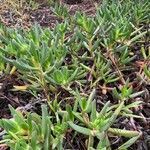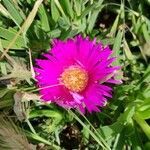A spreading succulent plant. It keeps growing from year to year and creeps over the ground. The stems are reddish brown. The leaves are opposite and 3 sided. They are fleshy. The leaves can be curved inwards. They are 3.5-10 cm long by 1-1.5 cm wide. The flowers are daisy like. The petals are light purple becoming white towards the centre. They are 4-6 cm across. The fruit is fleshy and oblong. It is purple or red and 2-3 cm long by 1.5-2.5 cm wide.


